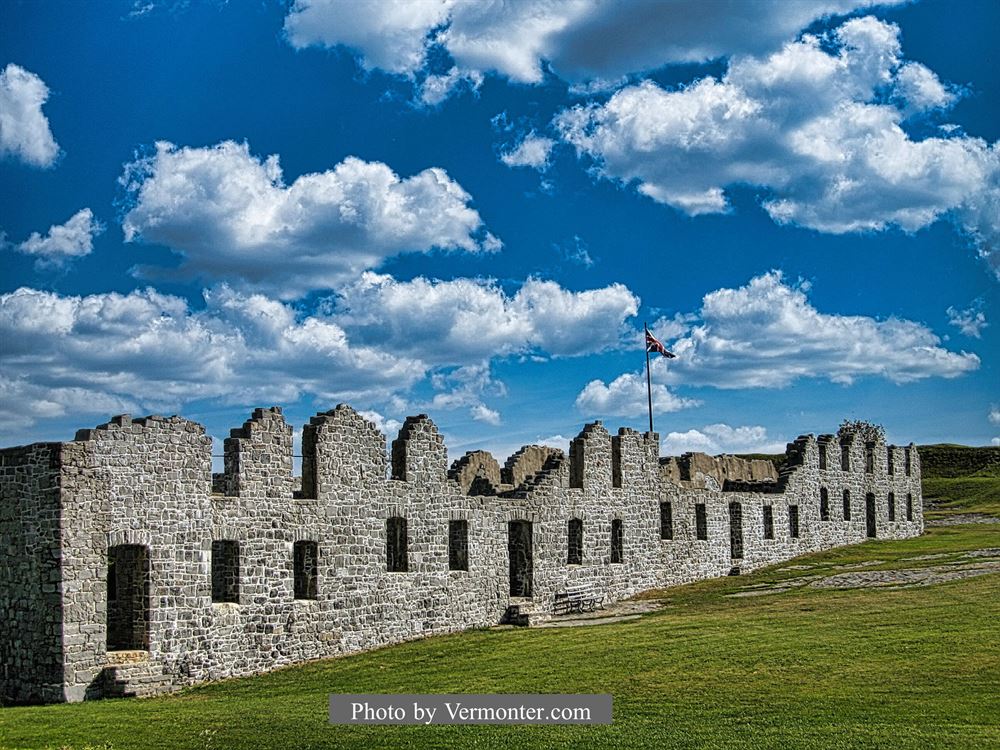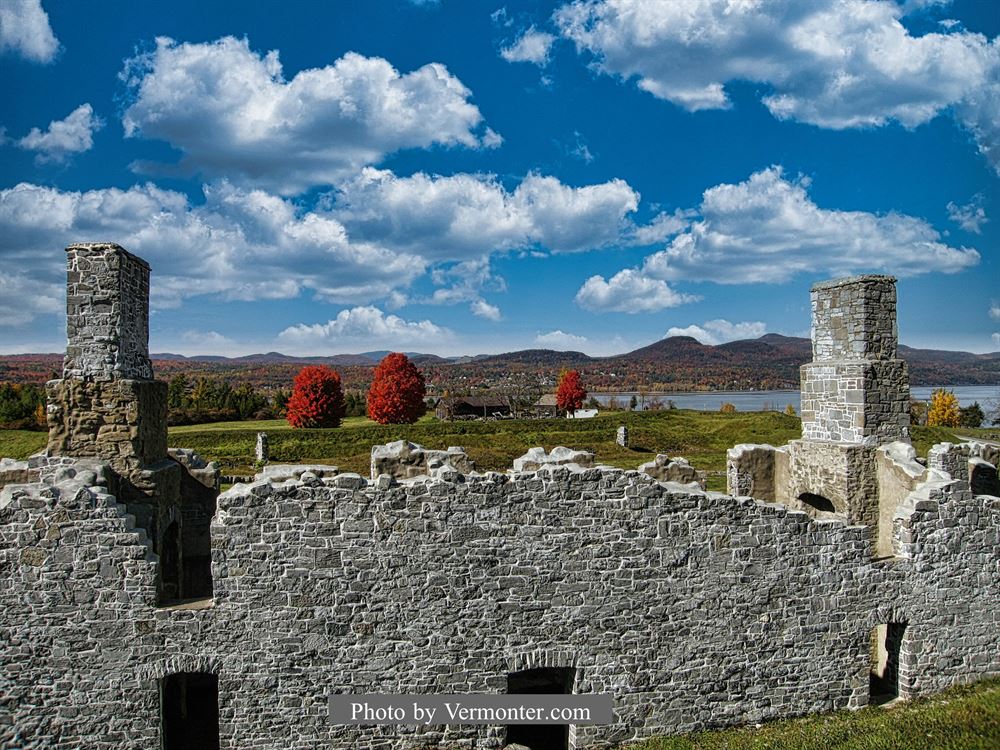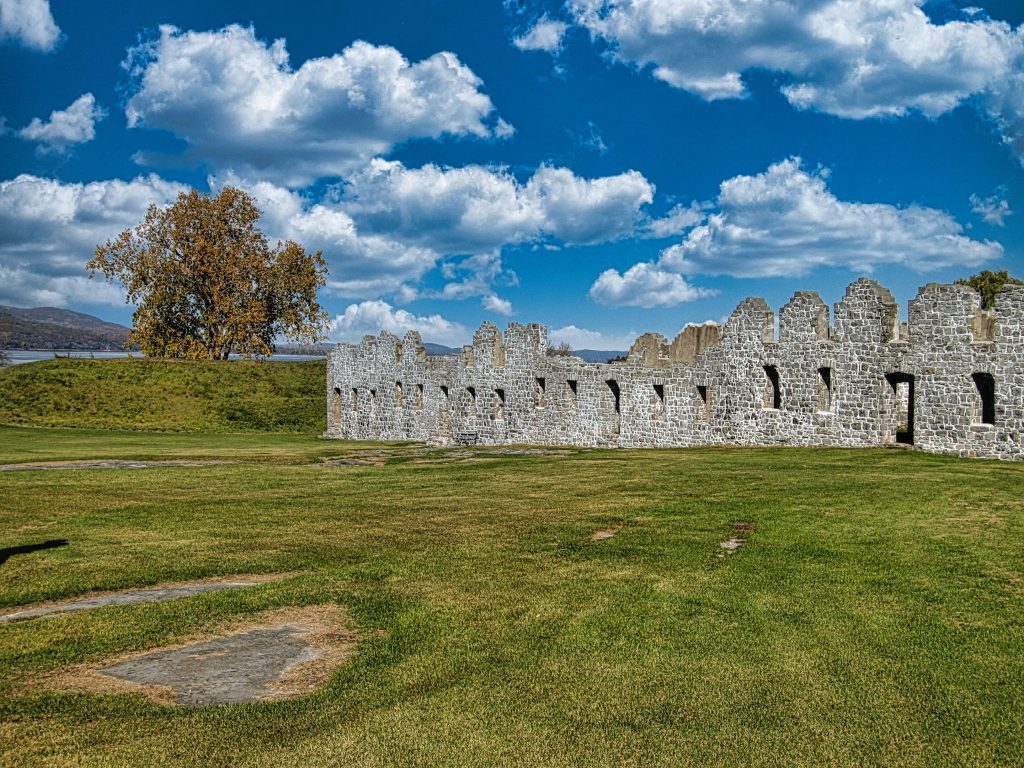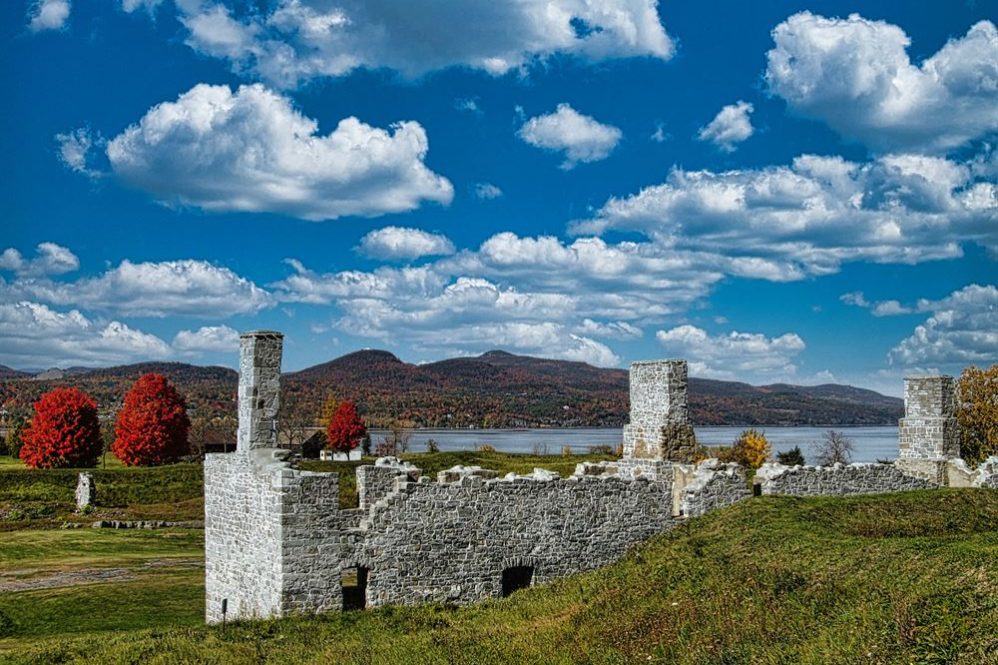The Champlain Bridge, commonly referred to as The Crown Point Bridge, is a major route connecting Vermont and New York at Chimney Point, Vermont and Crown Point, New York. If you're visiting from the Vermont side, the view of Lake Champlain is truly spectacular. As you drive across the bridge, the remnants of the Crown Point fort ruins, appear in the distance, stirring up curiosity, excitement and imagination.

The Crown Point New York Historic Site is located at 21 Grandview Drive in Crown Point, Essex County. It shows us the historic remains of Fort Saint-Frédéric and His Majesty's Fort of Crown Point. Located in the beautiful Lake Champlain Region of New York State, this must-see place tells a story of history and fight for control in America.
The French built Fort Saint-Frédéric between 1734 and 1737, a major power during wars. Then, in 1759, the British made His Majesty's Fort of Crown Point over seven acres. New York State got these ruins in 1910, keeping their story alive for us to enjoy and ponder.
These days, you can walk the grounds and visit. Open daily from dawn till dusk, it’s a spot for learning and fun. From May 18 to October 9, the Crown Point Campground also offers outdoor fun and beautiful views. Reserve through Reserve America. Information can be found on the campground website or 518-597-3603.

Key Takeaways
- The Crown Point New York Historic Site is located at 21 Grandview Drive in the Town of Crown Point, Essex County.
- Fort Saint-Frédéric was built by the French between 1734 and 1737.
- His Majesty's Fort of Crown Point was constructed by the British in 1759, covering over seven acres.
- The State of New York acquired the ruins of the forts in 1910 for historic preservation.
- The site is open year-round from sunrise to sunset and offers various educational and recreational opportunities.
- The Crown Point Campground is open from May 18 to October 9, providing various outdoor activities.
Introduction to Crown Point New York Historic Site
The Crown Point State Historic Site is at latitude 44.024853 and longitude -73.424377. It reveals the historic battles of the past between colonial Britain and France. The location shines a light on the American Revolutionary War as well. It looks over Lake Champlain, showing ruins of two forts: Fort St. Frederic by the French, and His Majesty's Fort of Crown Point by the British.
New York State obtained the site in 1910, and now it's a National Historic Landmark. Crown Point was a vital key in the French and Indian War and the American Revolutionary War. General John Burgoyne's army took over in 1777. Today, visitors can see the well-preserved ruins and learn history through interpretive displays.

| Feature | Details |
|---|---|
| Location | 44.024853, -73.424377 |
| Fort St. Frederic | Constructed between 1734-1737 by the French |
| His Majesty's Fort of Crown Point | Built in 1759 by the British, covering seven acres |
| Ownership | Acquired by New York in 1910 |
| Revolutionary War | Occupied by General John Burgoyne's army in 1777 |
| Visitor Centers | Open from May 15 to October 20, from 10 AM to 5 PM, Wednesdays through Sundays |
| Admission Fees | $5 for adults, $4 for seniors/veterans, free for children 12 and under, $35 for buses |
| Bird Watching | Over 200 species observed at the Crown Point Bird Conservation Area |
The site offers spectacular views of Lake Champlain and tells many stories through its ruins. The museum and visitor center, open from May to October, have exhibits about wars and local nature. It also has biking and hiking trails, picnic spots, and winter sports like snowshoeing and skiing.
Crown Point State Historic Site is perfect for history buffs and nature lovers. Visitors enjoy lessons in history and breathtaking views of Lake Champlain.
The Strategic Importance of Crown Point
The Champlain Valley is known for its vast waters and scenic beauty. It is home to Crown Point—an area famous for its military importance. This site along Lake Champlain was key in colonial wars between France and Britain. It controlled a vital passageway, crucial for moving and supplying troops between New York and New England.

In the early 18th century, the French built Fort St. Frederic. Constructed between 1734 and 1737, its four-story stone walls were a major French stronghold. Yet, the British knew how crucial this site was. They launched several campaigns to take it over. By 1759, they built “His Majesty's Fort of Crown Point,” covering over seven acres and becoming one of North America's largest British forts.
“Crown Point was a pivotal fortification, reflecting the intense rivalry and shifting control between the British and French during their quest for dominance over North America.”
Control of Crown Point changed between the British and French during the colonial wars. This shift mirrored the broader tactical situation of those times. Its strategic importance played a vital role not just in those conflicts but also in the American Revolutionary War. Today, Crown Point is celebrated in historical accounts and at the Crown Point State Historic Site.
| Event | Date | Details |
|---|---|---|
| Construction of Fort St. Frederic | 1734-1737 | French fort with 12-foot-thick stone walls |
| British Seizure and Construction | 1759 | Built “His Majesty's Fort of Crown Point” over seven acres |
| New York Acquisition | 1910 | State of New The state of New York took control of both historic forts. |
The French Fort Saint-Frédéric
Fort Saint-Frédéric was built from 1734 to 1737. It shows the French's smart military thinking and their long range goals in North America. Placed by Lake Champlain, it was key in the 18th-century colonial battles and skirmishes.
Construction and Design
The fort was amazing in design, with a huge four-story stone octagon. Its walls were 12 feet thick. Each floor had cannons, making it a very strong place that could take on large attacks.
Role in French Raids
Fort Saint-Frédéric's spot was perfect for French military moves. It wasn't just for defense but also for attacking British areas. This fort was a main spot for the French, leading many raids that pushed the British and kept the fight going in that area.
| Feature | Details |
|---|---|
| Architectural Design | Four-story stone octagon |
| Wall Thickness | 12 feet |
| Armament | Cannons on every floor |
| Functionality | Staging ground for raids |
British Fort Crown Point
In 1759, when the British took over from the French, it was a big moment for Crown Point. This change started the building of His Majesty's Fort of Crown Point. It became one of the biggest British forts in North America. The fort spread over seven acres. It showed off British design and strategy from that era. Fort Crown Point was a masterpiece of military building during the colonial wars.
Construction of His Majesty's Fort
Building His Majesty's Fort of Crown Point was a massive project. It showed the power and skill of British engineering. Right after the British gained control in 1759, they began to build a strong fort. Over time, the fort grew to cover more than seven acres. It was much bigger and stronger than the French's Fort St. Frederic. The fort's design focused on defense. Its thick walls and strategic points differed from the French's fancy stonework.
Colonial Conflicts
This British fort was key in the colonial wars. It guarded the important route connecting New York to New England. It stood by the Lake Champlain bridge, controlling a major military path. Fort Crown Point was at the heart of battles between the French and British empires. It saw many battles and changed hands often. It symbolized the ongoing fight for control in the New World.
Key Events at Crown Point during the American Revolutionary War
In 1775, Crown Point became a key spot in the American Revolutionary War. American colonists took it from the British, making a big win. This victory gave them access to vital cannons and ordnance for their fight for freedom. The fort at Crown Point, built by the British, turned into an important asset for the revolutionaries. But in 1777, things changed when General John Burgoyne's British forces took it back. This was part of their plan to stop the revolution.
After the Americans left, General Burgoyne's army moved in, showing how crucial Crown Point was in the war. These moments at Crown Point underline its strategic significance and its impact on the fight for independence.
The Role of General John Burgoyne and General Israel Putnam
In the Lake Champlain Region's history, Generals John Burgoyne and Israel Putnam are key figures. General Burgoyne led the British and aimed to isolate New England in 1777. His army of about 8,500 men moved south from Montreal, focusing on the strategic Lake Champlain.
General Burgoyne's invasion was carefully planned in two main parts. About 8,000 men took the Champlain route. Another group of 2,000 moved down the Mohawk River valley from Lake Ontario. Despite this, his campaign led to a turning point in the American Revolutionary War. Burgoyne's forces surrendered to American General Horatio Gates at Saratoga. This was a big win for the Americans.
Meanwhile, General Putnam was vital for the Americans. Known for his bravery, his strategies were key in the Lake Champlain fights. He showed American determination as they battled the British and their allies.
The Battle of Saratoga showcased General Putnam's military strength. It also led France to ally with the United States. This alliance brought much-needed help to the American forces, altering the war's course.
Together, the leadership of these generals, the importance of Lake Champlain, and the Americans' determination changed the war's direction.
Preservation and Archaeological Significance
The Crown Point State Historic Site preserves two important forts: Fort St. Frederic and His Majesty's Fort of Crown Point. Built by the French from 1734 to 1737, it was later expanded by the British. This site offers a fascinating look at colonial history.
Efforts in Historic Preservation
In 1910, New York State bought the ruins, showing a strong commitment to preservation. It was listed in the National Register of Historic Places in 1976. Today, visitors enjoy well-kept ruins and a museum filled with artifacts from archaeological work.
Archaeological Discoveries
Archaeologists have been digging here since the 1950s. They haven't found any human remains, making the findings even more significant. The artifacts tell stories of daily life and military strategy.
| Archaeological Element | Description | Availability |
|---|---|---|
| Original Artifacts | Artifacts recovered from the site | Displayed in museum |
| Guided Tours | Informative tours of the grounds | Contact for times and dates |
| Museum Admission | Original displays of artifacts | Contact for times and dates |
The site is dedicated to preserving history and sharing archaeological finds. It serves as both a battlefield monument and a place of learning. Every visit reveals more about the past, thanks to the hard work of archaeologists and historians.
Visiting Crown Point New York Historic Site
The Crown Point New York Historic Site is truly a beautiful spot on Lake Champlain. The views are breathtaking. It dives deep into American colonial history. The site is open every day, all year, from the morning light till sunset. And it's free to visit, so everyone can enjoy its history.
Visitor Information
Located at latitude 44.024853 and longitude -73.424377, the site welcomes all who love history or just enjoy beautiful sights. The nearby Crown Point Pier and the Champlain Memorial Lighthouse are great places for thinking and exploring. There are lovely paths by the Lake Champlain Bridge that lead to many interesting and scenic spots.
Museum and Exhibits
The Crown Point State Historic Site Museum is a must-see. It opens from May 15, 2024, to October 20, 2024. You can visit from 10 AM to 5 PM, Wednesday to Sunday. The museum has exhibits and an audio-visual presentation about the site's history. Admission is $5 for adults and $4 for seniors and veterans. Kids 12 and under get in free. Please double-check their website to confirm rates and hours.
Visitors can also take guided tours of the ruins. These tours tell the stories of Fort St. Frederic and His Majesty's Fort of Crown Point, built in 1734-1737 and 1759. Inside the museum, there are artifacts and displays. They explain the area's part in the American Revolutionary War and other colonial battles.
Around Crown Point, there are amenities like biking and hiking paths, and picnic areas that everyone can use. In the winter, you can go snowshoeing or cross-country skiing on trails. Crown Point offers many ways to learn and have fun, whether on your own or at special events.
Exploring the Crown Point Campground and State Park
The Crown Point Campground and State Park is located at 44.024853 latitude and -73.424377 longitude. It's a haven for nature lovers in the Lake Champlain Region. Managed by the NYS Department of Environmental Conservation, it welcomes guests from May 18 to October 9. Visitors can enjoy biking, hiking, or picnicking in this beautiful setting.
The park has eight miles of trails and is open every day from dawn until dusk. Pet owners can bring their dogs, but they must be leashed and have their shots up to date.
The Crown Point Bird Conservation Area is famous for watching bird migrations. Since 1976, over 126,000 birds of 110 species have been noted here. It's part of the Atlantic Flyway, a key route for migrating birds. The park also offers tours of historical ruins, including Fort St. Frederic and His Majesty's Fort of Crown Point. These tours help visitors learn about the park's rich history.
As an added plus, the magnificent, absolute “must-see” Fort Ticonderoga is only 28 minutes away, by car (17.1 mi) via Shore-Airport Rd. If you do venture to nearby Ticonderoga and are a Star Trek fan, make sure to check out the Star Trek Original Series Set Tour.
FAQ
What is the Crown Point State Historic Site?
The Crown Point State Historic Site is a significant location in New York State, famous for its historic preservation. Situated on the shore of Lake Champlain, it includes ruins of the French-built Fort Saint-Frédéric and the later British-built Fort Crown Point. It offers visitors a deep dive into the rich history of the French and Indian War, the American Revolution, and the Champlain Valley.
Where is the Crown Point State Historic Site located?
The Crown Point State Historic Site is located in the town of Crown Point, in Essex County, New York State. It is situated on the western shore of Lake Champlain, near the Lake Champlain Bridge.
What can you see at the Crown Point State Historic Site?
Visitors to the Crown Point State Historic Site can explore the ruins of two forts: the French-built Fort Saint-Frédéric and the British-built Fort Crown Point. Other points of interest include the Champlain Memorial Lighthouse, various cannons, and archaeological sites that reflect activities from the revolutionary war era. Additionally, the site offers access to the Lake Champlain Bridge and has beautiful views of the Champlain Valley and the Adirondack mountains.
What historical significance does Fort Crown Point hold?
Fort Crown Point was a key strategic military fortification during the French and Indian War and the American Revolution. The French built Fort Saint-Frédéric in 1734, and the British constructed Fort Crown Point in 1759. It played a significant role in the colonial conflicts between Britain and France, and later, during the battles for American independence in 1775 and 1777.
What are the available facilities at Crown Point State Historic Site?
The site offers a variety of amenities including a picnic area, a museum that houses exhibits on colonial and military history, and a reconstructed museum. The nearby Crown Point Campground provides camping facilities, which can be reserved beforehand made through ReserveAmerica.com.
Is Crown Point on the National Register of Historic Places?
Yes, the Crown Point State Historic Site is listed on the National Register of Historic Places. It is also designated as a National Historic Landmark, reflecting its significant role in American history
Thank you for visiting Vermonter.com! Please subscribe to our email list for the latest articles!





